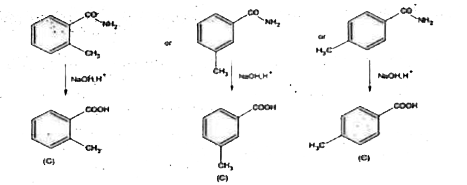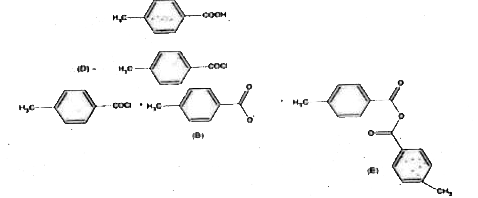The perentage of C, H, N in a disubtituted aromatic compound (A) is 71.11 , 6.67 and 10.37 respectively . Its molecule contains a single atom of nitrogen . Compound (A) gives NH3 when heated with NaOH to from a salt (B) form which an acid (C) is obtained on acidifcations. Two isomers are generated when (C) undergoes electrophilic aromatic substitution. (C) on treatement with PCl5 generates (D) which on reaction with (B) generates (E) . Identify (A) to (E).
Firstly , we should calculatedth empirical formula of the compound.
ElementPerecentageAt wt5by atomSimplest ratioC71.11125.9268H6.6716.679N10.37140.741O11.85160.741
Empirical formula of (A)is C6H0NO which is similar molecular formual as the molecule contains only one N. Since (A) gives off NH3 with NaOH is it clear that it has −CONH2 group. So, the possible strcucture are .

Since (C) gives only two isomeric Products on electrophilic aromatic substitution (C) is .

Topper's Solved these Questions
- CARBOXYLIC ACIDS AND ITS DERIVATIVESBOOK - FIITJEECHAPTER - CARBOXYLIC ACIDS AND ITS DERIVATIVESEXERCISE - SOLVED PROBLEMS (OBJECTIVE )
25 Videos
- CARBOXYLIC ACIDS AND ITS DERIVATIVESBOOK - FIITJEECHAPTER - CARBOXYLIC ACIDS AND ITS DERIVATIVESEXERCISE - SOLVED PROBLEMS (OBJECTIVE ) (COMPREHENSION)
3 Videos
- CARBOXYLIC ACIDS AND ITS DERIVATIVESBOOK - FIITJEECHAPTER - CARBOXYLIC ACIDS AND ITS DERIVATIVESEXERCISE - SINGLE INTEGER ANSWER TYPE QUESTIONS
1 Videos
- CARBOHYDRATES, AMINO ACIDS, POLYMERS AND PRACTICAL ORGANIC CHEMISTRYBOOK - FIITJEECHAPTER - CARBOHYDRATES, AMINO ACIDS, POLYMERS AND PRACTICAL ORGANIC CHEMISTRYEXERCISE - EXERCISE
4 Videos
- CHEMICAL ENERGETICS BOOK - FIITJEECHAPTER - CHEMICAL ENERGETICS EXERCISE - NUMERICAL BASED QUESTIONS
2 Videos
Similar Questions
The percentage of carbon, hydrogen, and nitrogen in an disibstituted aromatic compound (A) is 71.11,6.67, and 10.34, respectively. It molecule contains a single atom of nitrogen. Compound (A) evolves NH3 when heated with NaOH to form a salt (B) from which an acid (C) is obtained on acidification. If an electrophilic substitution is carried on (C), a leaving electrophile can occupy either of the two identical positions available in the ring. Acid (C) on heating with PCl5 gives (D) which reacts with (B) to give an organic product (E). Give the structures of (A) to (E) with proper reasoning.
View SolutionThe number of isomers of the aromatic compound C8H10 is :
View Solution
Knowledge Check
The number of isomers of the aromatic compound C8H10 is :
A3B4C2D5An aromatic compound A (C7H9N) on reacting with NaNO2 / HCI at 0∘C forms benzyl alcohol and nitrogen gas. The number of isomers possible for the compound A is
A5B7C3D6An aromatic compound 'A' (C7H9N) on reacting with NaNO2/HCl at 0∘C forms benzyl alcohol and nitrogen gas. The number of isomer possible for the compound 'A' is
A3B5C6D7
A and B are functional isomers of compound C3H6O. On heating with NaOH and I2 isomer A froms yellow percipitate of iodoform whereas isomer B does not form any precipitate. Write the formulae of A and B.
View SolutionA and B are functional isomers of compound C3H6O. On heating with NaOH and I2 isomer A froms yellow percipitate of iodoform whereas isomer B does not form any precipitate. Write the formulae of A and B.
View SolutionAn aromatic compound (A) on treatment with ammonia followed by heating forms compound (B), which on heating with Br2 and KOH forms a compound (C) having molecular formula C6H7N. Give the structures of A, B and C and write the reactions involved.
View SolutionAn aromatic compound (A) on treatment with aqueous ammonia and heating forms compound (B) which on heating with Br2 and KOH froms a compound (C ) of the molecular formula C6H7N. Write the structures and IUPAC names of compounds (A) . (B) and (C ).
View SolutionAn organic compound (A) C2H6O react with
sodium metal to form compound (B) with
evolution of H2 gas give yellow compound
(C) with alkaline iodine. When (A) is heated with
conc. H2SO4 at 413K gives a compound (D) C4H10O.
Which treatment with conc. HI at 373 K gives (E).
The compound ( D) also obtained when (B) is
heated with (E). Identify compound(E).
View Solution
